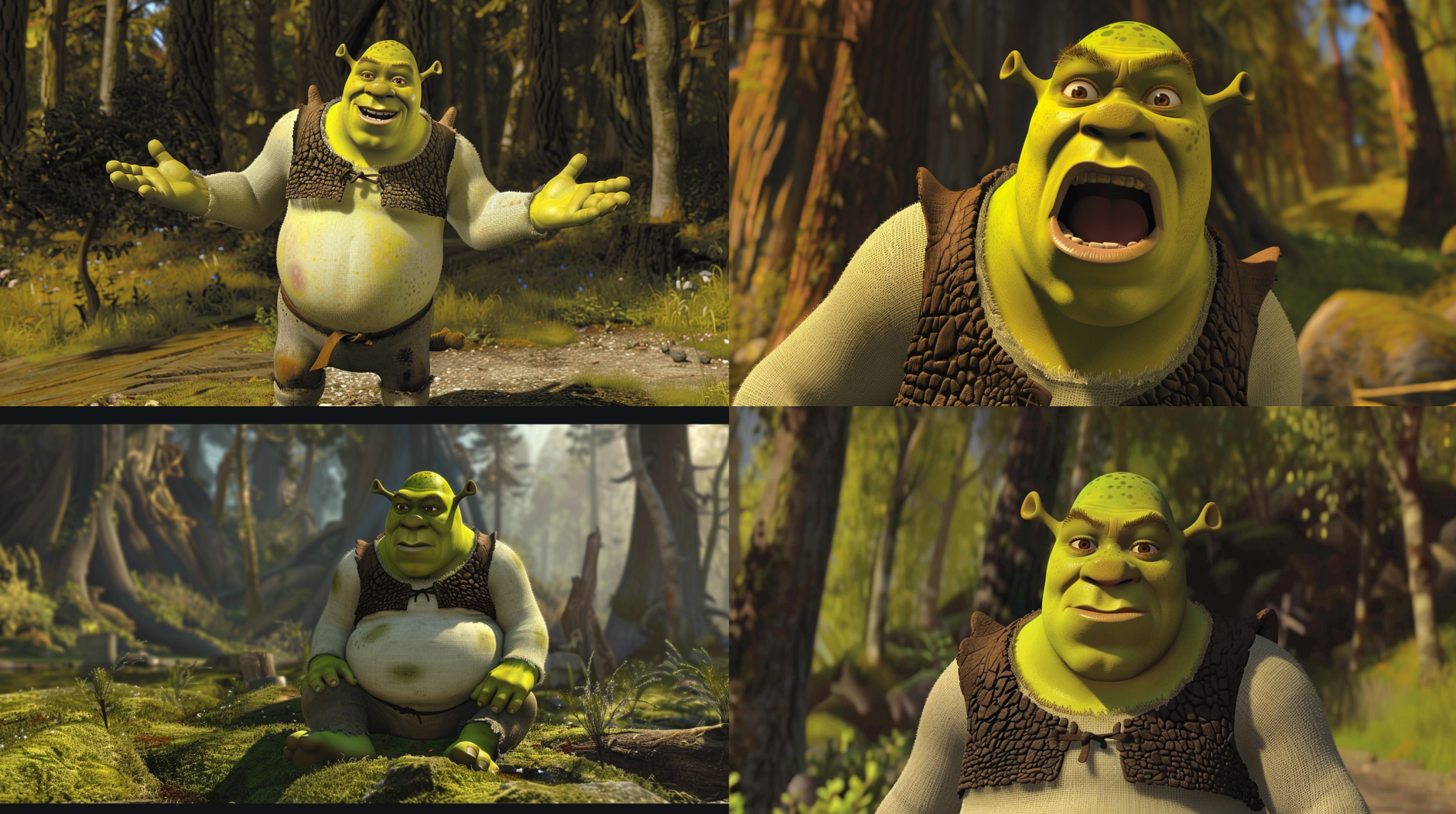Midjourney v6 prompts: Shrek test - 01
[note: testing in progress...]
Some machines are intuitive, meaning they're easy to sit down and use.
The design of the Play-Doh Basic Fun Factory Shape-Making Machine is intuitive.
There is a colorful plastic thing that looks like a stapler. At the front, there is a place to slide in a thin colorful plastic strip. The strip has holes cut out of it—different shapes, like circles, squares, and stars.
Once you've fit the strip in place, the shape centered, you lift the handle. There's a hole. You put Play-Doh in the hole. Then, when you push the stapler handle down, the Play-Doh comes out in your chosen shape. What happens next? That's up to you.
Change the shape. Combine Play-Doh colors. Feeling crazy? Chance the shape again.
"Literally anything" is impossible when using a Fun Factory Shape-Making Machine. The choices are very limited. The machine is very utilitarian. That's what makes it intuitive and enjoyable to use. Because just in the using of it you are, by default, "using it right."
Contrast this with AI Machines—the GPTs, the text-to-image generators, the virtual boyfriends—are not intuitive. Seated in front of your computer with its screen staring back at you—you get no visual clues as to how a given AI was engineered to function. They are not easy to use.
These machines need their users to tell them how to function. The Play-Doh, in this sense, is somewhere inside your own head. Instead of a strip of bright plastic with shapes punched out, we can slide any words we choose to use as prompts to help guide outputs. And, assuming we even know exactly what outputs we wanted (we often don't), there's no way to tell what these machines will produce when we push down the Return or Enter key.
When using these machines, anything may be possible (or not quite). Are you using the AI right? That's not clear. So, it can be confusing and frustrating to play with this dough.
For those willing to learn, however, articles like Medium's "100 Unbelievable Midjourney V6 Prompts to Transform Your Artistic Horizons" by [author] can be extremely useful.....[cont]
"Today marks the beginning of a new chapter in your creative journey. I am about to unveil a treasure trove of inspiration that will not only challenge your conventional perception of art but also catapult your digital creativity into uncharted territories. Welcome to the avant-garde universe of 100 Midjourney V6 Prompts!" - Saul Flores Jr. writing for Medium
For this Shrek test, we will select some prompts Saul features in his Medium post and try them as Shrek.
For a control, we ask Midjourney for "Shrek" in the 19:6 aspect ratio we'll use throughout:

Thoughts: These are good Shreks.
My guess this is due in equal parts to Shrek having a distinct and simple yet consistent design, and Shrek as a meme resulting in lots of images online to use as training data.
It's also interesting that, in presenting its four options, Midjourney also gave us the Four Emotional Seasons of Shrek (clockwise from upper-left in image above): Agreeable Shrek, Alarmed Shrek, Shrek, and Seated Shrek.
Moving on to the test—Saul used "woman" as the consistent subject for each prompt featured in his post. In order to satisfy the parameters of this test, I will simply substitute "woman" for "Shrek."
Midjourney v6 prompt test 1: "[Shrek] in the style of Asemic Writing"
From article: "Let the silence speak volumes. Create art that whispers the unsaid, with lines and forms that dance between meaning and mystery. Asemic writing isn’t just writing; it’s the music of the soul captured in visual form."

Context: I had to look up what Asemic Writing is:
- [It] is a form of abstract, wordless writing that conveys meaning through visual aesthetics rather than conventional language
- Asemic writing resembles traditional writing/calligraphy but does not contain actual words or semantic content
- Sidebar: Semantic content, Asemic definition
- Considered an international, universal form of communication that transcends language barriers
- Can take many visual forms, such as abstract calligraphy, damaged/illegible text, or symbolic markings that suggest writing
- Notable artists associated with asemic writing include Cy Twombly, Wassily Kandinsky, and contemporary artists like Satu Kaikkonen
- The process of creating asemic writing is often described as meditative and freeing, allowing the artist to express themselves without the constraints of language
Thoughts: Now, with a shallow understanding of asemic writing, thinking of it as a visual style brings to mind Bruce Lee and "the art of thinking, without thinking." Or, here, the art of writing, without writing.
Midjourney v6 prompt test 2: "[Shrek] in the style of Gothic Revival"
From article: "Reawaken the grandeur of Gothic architecture through your art. Gothic Revival is a journey back in time, a tribute to the towering spires, intricate traceries, and the silent stories of ancient stones."

Post a comment